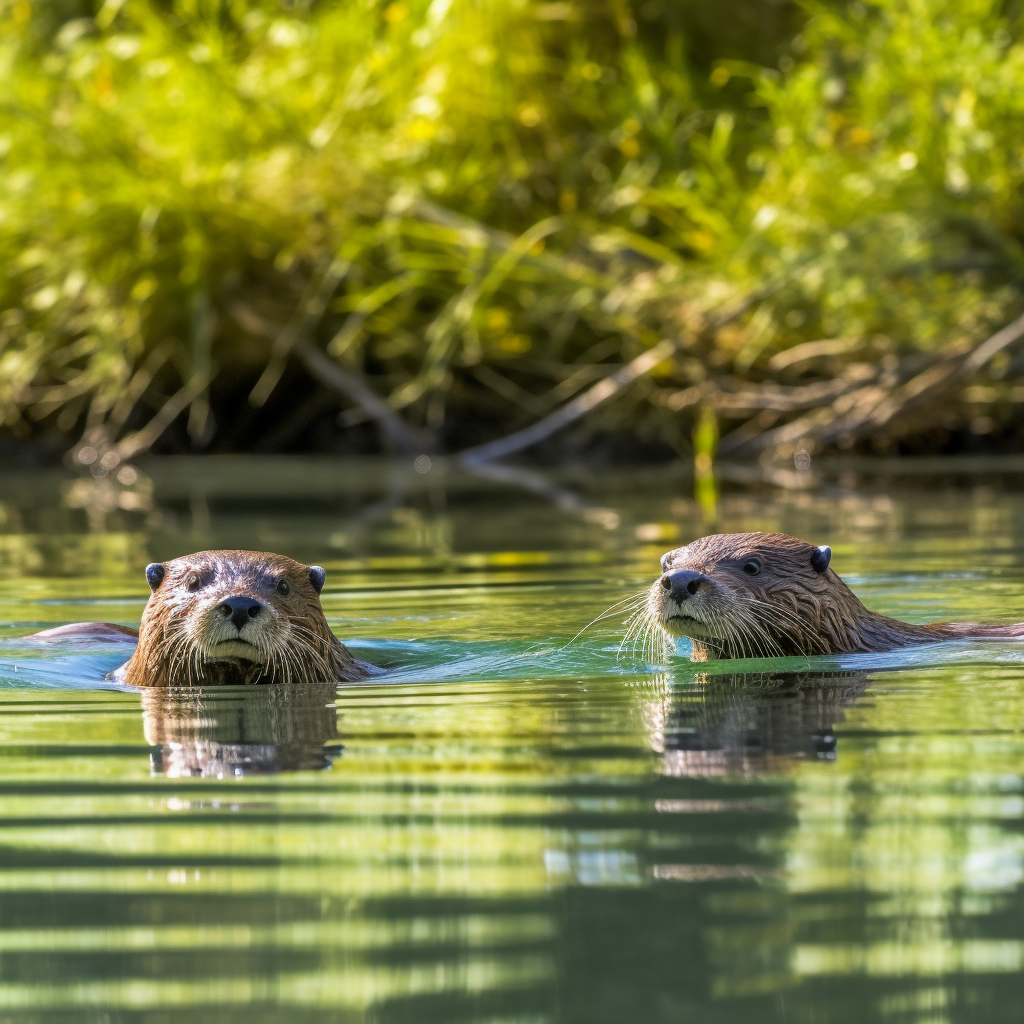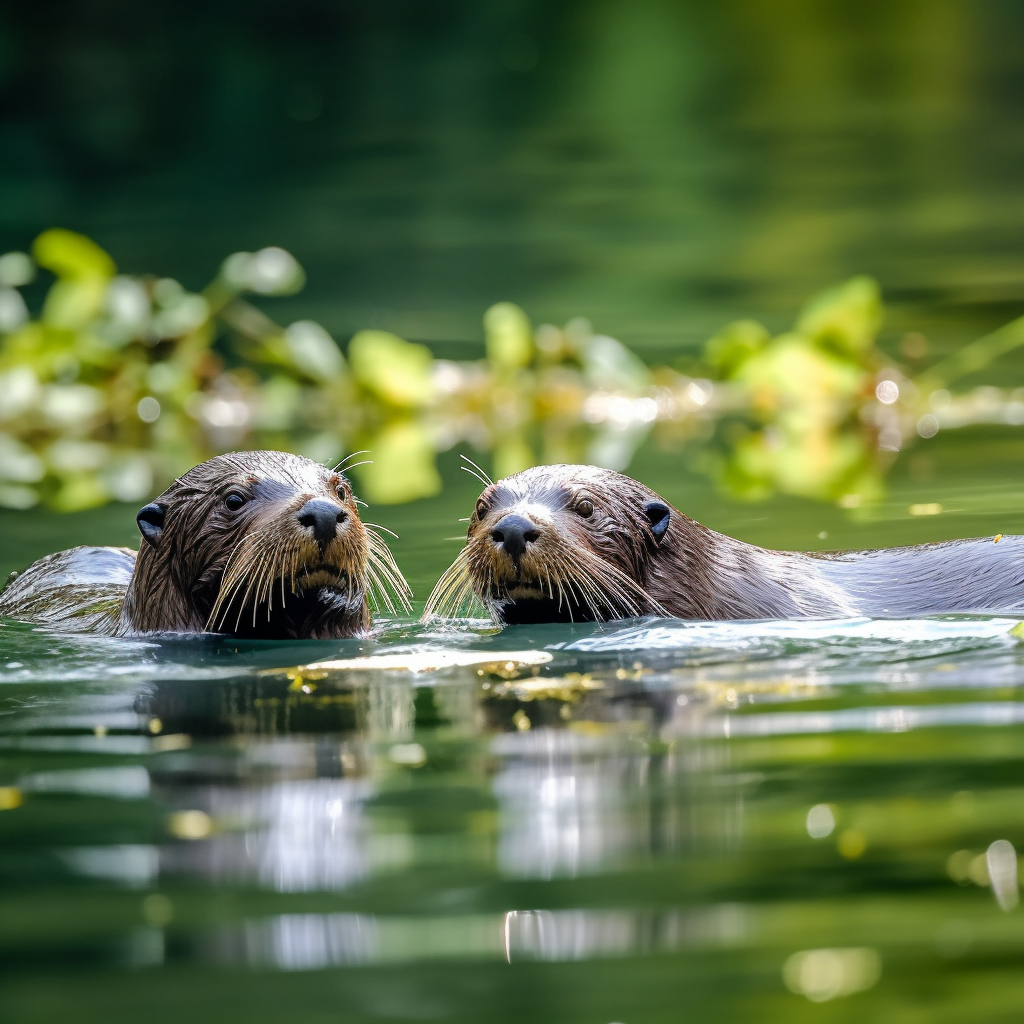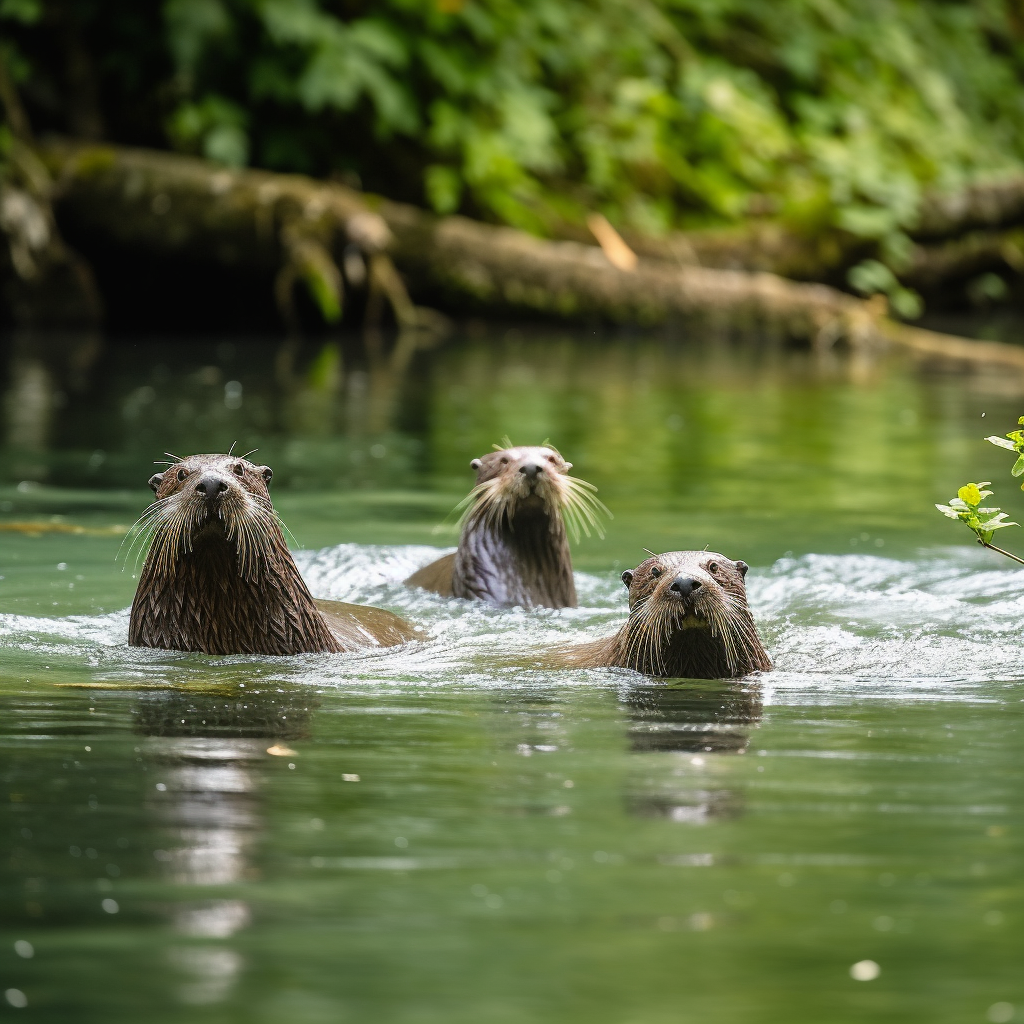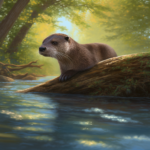River otters are fascinating creatures that can be found in various regions of North America, including Washington State. These playful and intelligent mammals are known for their sleek bodies, webbed feet, and long, muscular tails, which make them excellent swimmers. River otters are highly adaptable and can thrive in a variety of aquatic habitats, including rivers, lakes, and coastal areas. In Washington State, these charismatic animals can be spotted in numerous waterways, from the Puget Sound to the Columbia River. With their playful antics and important ecological role, river otters are a beloved and iconic species in Washington State’s diverse wildlife population. So, let’s dive into the world of river otters and discover more about these enchanting creatures.
Key Takeaways
- River otters are native to Washington State and can be found in various habitats such as rivers, lakes, and coastal areas.
- They are highly adaptable and have a diverse diet that includes fish, amphibians, crustaceans, and small mammals.
- River otters play a crucial role in maintaining the ecological balance of aquatic ecosystems.
- Conservation efforts are important to protect river otters and their habitats, including preserving water quality and ensuring sufficient food sources.
- Observing river otters in the wild can be a rewarding and educational experience, but it is important to maintain a safe distance and not disturb their natural behavior.
The Existence of River Otters in Washington State

A. Overview of River Otters in Washington State
River otters are fascinating creatures that can be found in various parts of Washington State. These playful and intelligent animals are a common sight in the state’s freshwater ecosystems, including rivers, lakes, and wetlands. Washington State is home to the North American river otter, a species known for its adaptability and ability to thrive in diverse habitats.
1. Otter Conservation Efforts
In recent years, there has been a concerted effort to protect and conserve river otters in Washington State. These efforts have focused on preserving their habitats, ensuring clean water quality, and minimizing human disturbances. The Washington Department of Fish and Wildlife, along with various conservation organizations, has played a crucial role in monitoring otter populations and implementing measures to safeguard their well-being.
2. Otter Behavior and Diet
River otters are highly social animals and often live in family groups called “rafts.” They are excellent swimmers and spend a significant amount of time in the water, where they hunt for fish, amphibians, crustaceans, and other aquatic prey. Otters are known for their playful nature, often engaging in sliding down muddy banks or engaging in mock fights with their companions.
B. Habitats and Locations to Spot River Otters in Washington State
If you’re interested in observing river otters in their natural habitat, Washington State offers several locations where you have a good chance of spotting these charismatic creatures.
1. Washington State Parks
Many Washington State parks provide ideal habitats for river otters. Places like Olympic National Park, Mount Rainier National Park, and North Cascades National Park offer diverse ecosystems that support otter populations. These parks have rivers, lakes, and wetlands where otters can find ample food and suitable shelter.
2. Rivers and Lakes
Washington State is blessed with numerous rivers and lakes that serve as prime otter habitats. The Skagit River, Columbia River, and Snake River are known to have healthy otter populations. Additionally, lakes such as Lake Washington, Lake Chelan, and Lake Roosevelt are also home to these aquatic mammals.
3. Wetlands and Estuaries
Wetlands and estuaries are crucial for otter survival, as they provide abundant food sources and shelter. Places like the Nisqually National Wildlife Refuge, Grays Harbor National Wildlife Refuge, and Willapa National Wildlife Refuge are excellent spots to observe otters in their natural wetland habitats.
4. Coastal Areas
While river otters primarily inhabit freshwater ecosystems, they can also be found along the coast of Washington State. Coastal areas such as the Olympic Peninsula and Puget Sound provide opportunities to spot otters as they forage for food along the shoreline.
In conclusion, Washington State offers a rich and diverse range of habitats where river otters can thrive. Whether you visit a state park, explore a river or lake, venture into wetlands, or explore the coastal areas, keep your eyes peeled for these playful creatures. Remember to observe them from a safe distance and respect their natural environment to ensure their continued existence in Washington State.
Comparing Otter Species: River Otters vs Sea Otters

A. Presence of Sea Otters in Washington State
Washington State is home to a diverse range of wildlife, including two distinct species of otters: river otters and sea otters. While river otters are commonly found throughout the state, sea otters have a more limited presence. Sea otters are primarily found along the coastlines of Washington State, particularly in the Olympic Coast National Marine Sanctuary and the waters surrounding the San Juan Islands.
Sea otters were once abundant along the entire west coast of North America, including Washington State. However, due to excessive hunting during the fur trade era, their population drastically declined. By the early 20th century, sea otters were nearly extinct in Washington State. In an effort to restore their population, sea otters were reintroduced to the state in the 1960s. Today, their numbers are slowly recovering, but they remain a protected species due to their vulnerable status.
B. Differences Between River Otters and Sea Otters
While both river otters and sea otters belong to the same family of aquatic mammals, they have distinct differences in their physical characteristics, habitats, and behaviors.
- Physical Characteristics:
- River otters: River otters have sleek, streamlined bodies with long, muscular tails that help them navigate through water. They have short legs and webbed feet, which make them excellent swimmers. Their fur is thick and waterproof, providing insulation in cold water.
-
Sea otters: Sea otters have a larger and bulkier body compared to river otters. They have shorter tails and webbed feet, which are adapted for swimming and diving. Sea otters have the densest fur of any mammal, with up to a million hairs per square inch, which helps them stay warm in the chilly ocean waters.
-
Habitats:
- River otters: River otters are primarily found in freshwater ecosystems, such as rivers, lakes, and marshes. They are adaptable and can also inhabit coastal areas if there is an abundant food source.
-
Sea otters: Sea otters, as the name suggests, inhabit marine environments, including coastal waters, estuaries, and kelp forests. They rely on the ocean for their food and shelter.
-
Behaviors:
- River otters: River otters are highly social animals and often live in family groups. They are known for their playful behavior, frequently sliding down muddy banks or snow-covered slopes. River otters are skilled hunters and have a varied diet that includes fish, amphibians, crustaceans, and small mammals.
- Sea otters: Sea otters are also social animals and can be found in groups called rafts. They spend a significant amount of time grooming their fur to maintain its insulating properties. Sea otters primarily feed on shellfish, such as clams, crabs, and sea urchins. They use rocks as tools to crack open their prey.
In conclusion, while river otters and sea otters are both fascinating creatures, they have distinct differences in their habitats, physical characteristics, and behaviors. River otters thrive in freshwater ecosystems, while sea otters are adapted to marine environments. Understanding these differences helps us appreciate the unique qualities of each species and the importance of their conservation in Washington State.
River Otters Beyond Washington: Are There River Otters in Oklahoma?
A. The Range and Distribution of River Otters in the United States
River otters are fascinating aquatic mammals that can be found across various regions of North America. While they are commonly associated with the Pacific Northwest, particularly Washington State, river otters can also be found in other parts of the United States, including Oklahoma.
The range and distribution of river otters in the United States is quite extensive. These playful creatures can be found in many freshwater ecosystems, including rivers, lakes, swamps, and marshes. They are highly adaptable and can thrive in both rural and urban environments.
In terms of their distribution, river otters have a wide presence across the United States. They can be found in almost every state, with the exception of a few areas in the arid southwestern regions. This widespread distribution is a testament to the resilience and adaptability of these remarkable animals.
B. Understanding the Habitat Preferences of River Otters
River otters have specific habitat preferences that contribute to their survival and overall well-being. Understanding these preferences can help us better appreciate their presence in different states, including Oklahoma.
-
Water Quality: River otters are highly dependent on clean and healthy water sources. They prefer habitats with good water quality, as it directly affects their ability to find food and maintain their overall health. Pollution and habitat degradation can have a detrimental impact on their populations.
-
Abundance of Prey: River otters are skilled hunters and primarily feed on fish, amphibians, crustaceans, and small mammals. They prefer habitats with an abundant food supply, such as rivers and lakes with diverse aquatic ecosystems. These areas provide a steady source of prey for otters to sustain themselves.
-
Shelter and Denning Sites: River otters require suitable shelter and denning sites to rest, breed, and raise their young. They often utilize natural cavities, such as hollow logs, rock crevices, or abandoned beaver lodges, as their dens. These secluded areas provide protection from predators and adverse weather conditions.
-
Vegetation and Riparian Zones: River otters are known to be semi-aquatic, meaning they spend time both in water and on land. They prefer habitats with ample vegetation and riparian zones along the water’s edge. These areas offer cover for otters to hide, rest, and engage in social behaviors.
-
Connectivity and Travel Corridors: River otters are highly mobile animals and require connectivity between different water bodies. They often use rivers, streams, and other waterways as travel corridors, allowing them to move between habitats in search of food, mates, and suitable denning sites.
By considering these habitat preferences, researchers and conservationists can work towards protecting and preserving suitable habitats for river otters in states like Oklahoma. This ensures the long-term survival of these charismatic creatures and the ecological balance of their respective ecosystems.
In conclusion, while river otters are commonly associated with Washington State, they can also be found in various other states across the United States, including Oklahoma. Understanding their range, distribution, and habitat preferences is crucial for their conservation and the overall health of freshwater ecosystems. By appreciating the presence of river otters beyond Washington, we can foster a deeper connection with these remarkable creatures and work towards their protection and well-being.
The Health Risks Associated with River Otters
A. Do River Otters Carry Diseases?
River otters, like any other wildlife species, can carry diseases. However, the risk of contracting a disease from a river otter is relatively low. It is important to note that healthy river otters are not typically carriers of diseases that can be transmitted to humans. Nevertheless, it is always wise to exercise caution and take necessary precautions when encountering any wild animal.
One of the diseases that river otters can carry is known as giardiasis. Giardiasis is caused by a microscopic parasite called Giardia, which can be found in the intestines of infected animals, including river otters. This disease can be transmitted to humans through the ingestion of contaminated water or food. Symptoms of giardiasis in humans include diarrhea, abdominal pain, and nausea.
Another disease that river otters can carry is called leptospirosis. Leptospirosis is caused by bacteria of the genus Leptospira, which can be found in the urine of infected animals. Humans can contract leptospirosis through contact with contaminated water or soil. Symptoms of leptospirosis in humans can range from mild flu-like symptoms to more severe conditions such as liver and kidney damage.
To minimize the risk of contracting diseases from river otters, it is important to practice good hygiene. Avoid direct contact with river otters and their waste. If you come into contact with river otter droppings or urine, wash your hands thoroughly with soap and water. Additionally, it is advisable to avoid swimming in areas where river otters are known to frequent, especially if the water quality is questionable.
B. Are River Otters Dangerous to Humans?
While river otters are generally not dangerous to humans, it is important to remember that they are wild animals and should be treated with respect. River otters are curious and playful creatures, but they can become aggressive if they feel threatened or cornered.
In most cases, river otters will avoid human contact and prefer to retreat to the safety of the water. However, if a river otter feels threatened, it may display defensive behaviors such as growling, hissing, or lunging. It is important to give river otters their space and avoid approaching them.
It is also worth noting that river otters have sharp teeth and claws, which they use for hunting and defense. If a river otter were to bite or scratch a human, it could potentially cause injury. Therefore, it is best to observe river otters from a safe distance and avoid any attempts to touch or interact with them.
In summary, while river otters can carry diseases and may display defensive behaviors if threatened, they are generally not dangerous to humans. By practicing good hygiene and respecting their space, the risk of encountering any health risks or dangerous situations with river otters can be minimized.
The Legal Status and Protection of River Otters in Washington State

A. Are River Otters Protected in Washington State?
River otters, known scientifically as Lontra canadensis, are protected wildlife in Washington State. These charismatic creatures are native to North America and are commonly found in the Pacific Northwest, including Washington State. The state recognizes the importance of preserving their populations and has implemented laws and regulations to ensure their protection.
Under the Washington Administrative Code (WAC), river otters are classified as a “protected species.” This designation means that it is illegal to hunt, trap, or harm river otters without proper permits or licenses. The Washington Department of Fish and Wildlife (WDFW) enforces these regulations to safeguard the otter population and their habitats.
The protection of river otters in Washington State is crucial for maintaining the ecological balance of freshwater ecosystems. These aquatic mammals play a vital role in the health of rivers, lakes, and wetlands. By regulating their populations, the state aims to preserve the biodiversity and overall well-being of these habitats.
B. The Role of Conservation Efforts in Protecting River Otters
Conservation efforts play a significant role in protecting river otters in Washington State. Various organizations, including government agencies, non-profit groups, and research institutions, work tirelessly to study and conserve these fascinating creatures.
One such organization is the Washington Department of Fish and Wildlife (WDFW). They conduct research on river otters to better understand their behavior, habitat requirements, and population dynamics. This information helps inform conservation strategies and management plans to ensure the long-term survival of otter populations.
Additionally, the WDFW collaborates with other stakeholders, such as landowners, educators, and outdoor enthusiasts, to raise awareness about the importance of otter conservation. Through educational programs, public outreach, and partnerships, they promote responsible behavior and encourage individuals to appreciate and protect river otters and their habitats.
Conservation efforts also extend to the establishment and maintenance of protected areas, such as state parks and wildlife refuges. These designated spaces provide safe havens for river otters and other wildlife, allowing them to thrive undisturbed. By preserving natural habitats and ensuring clean water sources, these protected areas contribute to the overall well-being of otter populations.
In conclusion, river otters in Washington State are legally protected to safeguard their populations and preserve the ecological balance of freshwater ecosystems. Through the implementation of laws and regulations, as well as conservation efforts by organizations like the Washington Department of Fish and Wildlife, these charismatic creatures can continue to enchant us with their playful antics and contribute to the health of our natural environment.
The Importance of River Otters in the Ecosystem
A. Why Are River Otters Important?
River otters are fascinating creatures that play a crucial role in the ecosystem of Washington State. These North American river otters, also known as Lontra canadensis, are highly adaptable and can be found in a variety of habitats, including rivers, lakes, wetlands, and coastal areas. Their presence is not only a delight for wildlife enthusiasts but also essential for maintaining the balance of the ecosystem.
One of the primary reasons why river otters are important is their impact on biodiversity. As aquatic mammals, otters contribute to the overall health of freshwater ecosystems. They are excellent indicators of water quality, as their presence indicates a healthy and thriving ecosystem. Conversely, their absence or decline in numbers can be a sign of environmental degradation.
B. The Impact of River Otters on Biodiversity and Ecosystem Health
River otters have a significant impact on the biodiversity and overall health of Washington State’s ecosystems. Their presence helps regulate the populations of various species, ensuring that no single species becomes dominant and disrupts the delicate balance of the ecosystem.
These playful creatures are skilled hunters and feed on a wide range of prey, including fish, amphibians, crustaceans, and even small mammals. By controlling the populations of these prey species, otters help maintain the health and diversity of the ecosystem. They prevent any one species from overwhelming others, which can lead to imbalances and negative consequences for the ecosystem as a whole.
Additionally, river otters are known to create and maintain habitats that benefit other species. They dig burrows, known as holts, along riverbanks and shorelines. These holts provide shelter for other animals, such as muskrats, minks, and even birds. The presence of otters in an area can lead to increased biodiversity and create a thriving habitat for a variety of species.
Furthermore, river otters are important for the dispersal of seeds. As they move through their habitats, otters inadvertently carry seeds on their fur and paws, helping to spread plant species and promote vegetation growth along waterways. This process is vital for maintaining healthy riparian zones and supporting the overall ecological balance.
In conclusion, river otters are essential for the health and vitality of Washington State’s ecosystems. Their presence indicates a thriving environment, and their impact on biodiversity helps maintain the delicate balance of the ecosystem. By controlling prey populations, creating habitats, and aiding in seed dispersal, these charismatic creatures play a vital role in preserving the natural beauty and diversity of the Pacific Northwest.
The Potential Dangers of River Otters
A. Are River Otters Dangerous?
When it comes to encounters with wildlife, it’s natural to wonder about potential dangers. In the case of river otters, however, there is generally little cause for concern. River otters are not typically aggressive towards humans and are more likely to avoid contact altogether. They are known for their playful and curious nature, which often leads them to approach people out of curiosity rather than aggression.
While river otters may seem harmless, it’s important to remember that they are wild animals and should be treated as such. It’s always best to observe them from a safe distance and avoid any attempts to touch or interact with them. This not only protects you but also ensures the well-being of the otters themselves.
B. Understanding the Behavior and Temperament of River Otters
To better understand the behavior and temperament of river otters, it’s important to delve into their natural instincts and characteristics. River otters are highly adaptable and can be found in a variety of habitats, including freshwater ecosystems such as rivers, lakes, and wetlands. They are excellent swimmers and spend a significant amount of time in the water, where they hunt for fish, amphibians, and other aquatic prey.
River otters are social animals and often live in family groups, known as rafts. These rafts typically consist of a female otter, her offspring, and sometimes a male otter. They communicate through a variety of vocalizations, including chirps, whistles, and growls.
When it comes to their interactions with humans, river otters are generally non-confrontational. However, if they feel threatened or cornered, they may exhibit defensive behaviors such as hissing, snarling, or lunging. It’s important to give them space and avoid any actions that may provoke them.
In rare cases, river otters may carry diseases such as rabies or parasites like fleas and ticks. However, the risk of contracting these diseases from otters is extremely low, especially if you maintain a safe distance and avoid direct contact.
Overall, while river otters are not typically dangerous, it’s crucial to respect their space and observe them from a distance. By doing so, we can coexist peacefully with these fascinating creatures and appreciate their important role in Washington State’s ecosystems. Conclusion
In conclusion, river otters in Washington State are fascinating creatures that play a vital role in the ecosystem. With their sleek bodies, webbed feet, and playful nature, these otters are well-adapted to their aquatic lifestyle. They are excellent swimmers and can dive underwater for several minutes in search of food. River otters are known for their playful behavior, often sliding down muddy banks and engaging in social interactions with their family members. They primarily feed on fish, crustaceans, and amphibians, helping to maintain a balanced ecosystem. While they were once threatened by habitat loss and pollution, conservation efforts have helped to increase their population in Washington State. It is important for us to continue protecting their habitats and ensuring their survival for future generations to enjoy. So, let’s appreciate and admire these charismatic creatures and do our part in preserving their natural habitats.
Frequently Asked Questions
Are there river otters in Oklahoma?
Yes, North American river otters are found in Oklahoma. They inhabit various water bodies including rivers, streams, lakes, ponds and marshes.
Are there sea otters in Washington State?
No, sea otters are not typically found in Washington State. However, the state is home to river otters which are a different species of otter.
Do river otters carry diseases?
Yes, river otters can carry diseases such as rabies and distemper, which can be transmitted to other animals and potentially to humans. However, such cases are relatively rare.
Are there otters in Washington State?
Yes, Washington State is home to the North American river otter. They can be found in various aquatic habitats throughout the state.
Are river otters protected in Washington State?
Yes, river otters are protected under Washington State law. It is illegal to harm, harass, or kill these animals without a specific permit.
Are river otters dangerous?
River otters are generally not dangerous to humans unless they feel threatened or cornered. They are wild animals and should be observed from a distance.
Why are river otters important?
River otters play a crucial role in maintaining the health of freshwater ecosystems. They control the population of certain aquatic species and their presence is often an indicator of good water quality.
Are river otters dangerous to humans?
While river otters are typically not aggressive towards humans, they can become defensive if they feel threatened. It’s best to observe these animals from a distance and not attempt to feed or touch them.
Where can I see river otters in Washington State?
River otters can be spotted in various aquatic habitats throughout Washington State, including rivers, lakes, and marshes. Some popular locations include the Olympic National Park and the Nisqually National Wildlife Refuge.
What is the diet of a river otter?
River otters are carnivorous and their diet mainly consists of fish. However, they also eat a variety of other foods including amphibians, crustaceans, and occasionally small mammals and birds.




